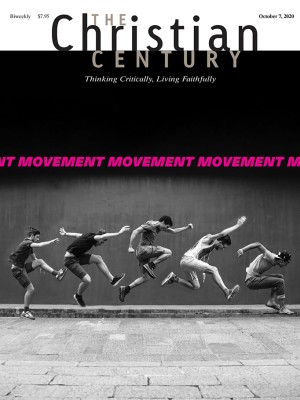Four ways faith leaders can shift to trauma-informed ministry
When everyone is traumatized, caregiving takes on new dimensions.

These days, we live in an environment of widespread individual and collective trauma. The pandemic wears on, causing heightened anxiety about who is safe, where it is safe, and which air is safe to breathe. High unemployment and economic worries continue. Racial injustice persists. The killing of George Floyd, Breonna Taylor, and others serves as a haunting reminder that safety has always been tenuous for those made vulnerable by systemic oppression.
Americans are experiencing a disruption in their fundamental sense of safety and questioning the assumptions they previously held. What can faith leaders do to support resilience in the people and communities they serve?
1. Know the science of trauma.
Trauma is a way of experiencing life-threatening circumstances that result in distress. People dealing with trauma may experience psychologically intrusive symptoms: recurrent memories, flashbacks, disturbing dreams, and physiological reactions to reminders of the event. At the same time, they may experience avoidance symptoms: numbing, dissociation, retreating from reminders of the event.
Read our latest issue or browse back issues.
Even those who aren’t showing extreme symptoms of posttraumatic stress may find it hard to concentrate or focus. This “brain fog” happens during stressful events because the brain shuts down those parts that do higher-functioning work in order to allow other parts of the brain, those tasked with basic survival, to take over. In particular, the prefrontal cortex—the part of the brain that handles tasks like solving problems, self-control, long-term planning, and decision making—functions less prominently than it does in non-stressful situations.
Knowing how stress works in the brain can help faith leaders minister more effectively during our current collective crises. If they are aware that their people are likely to have difficulty concentrating during stress, then they might craft a simpler sermon and deliver it more slowly to help people process what is being said. They might try to keep meeting agendas short. They might allow more space in individual conversations, with longer silences to allow thought processes to unfold.
2. Make physical, psychological, and spiritual safety a pastoral issue.
In Trauma and Recovery, psychiatrist Judith Herman outlines three steps for healing from trauma. The first is securing physical and psychological safety. Without safety, the body is stuck in fight-or-flight-or-freeze mode. In order to begin psychological recovery, survivors first need to have their basic needs for safety met: a safe place to live, the assurance of food and clothing, emotional regulation, spiritual safety, physical separation from the cause of the trauma, a sense of security at home and in the neighborhood.
In the second stage of trauma recovery, survivors begin to process the trauma through remembrance and mourning. This stage involves speaking about the trauma, contextualizing it, and naming what’s been lost as a result. In the third stage, survivors reconnect with the community, often developing a new sense of self that includes the trauma within it. During this stage, they might speak more publicly about their experience or participate in advocacy work.
Faith leaders often feel most drawn to the second and third tasks. Chaplains, spiritual directors, and pastors are in the business of meaning making, and faith provides the tools: a worldview that believers can use to structure their understanding of the world, stories for making sense out of realities that feel chaotic, a vocabulary for speaking about events that otherwise seem incommunicable. But this valuable meaning-making work can only occur once safety has been achieved.
The questions of safety that haunt so many in the United States these days are calling faith leaders to foreground physical and psychological safety. They might name the ways community members are struggling to feel safe. They might explain how the stress of systemic oppression contributes to a sense that basic safety needs aren’t being met. They might seek out online resources—from financial support services to prayer and meditation practices—that help provide safety to those who lack it. They might also consider how their own safety feels threatened in these times and seek out resources as needed.
3. Turn to the evergreen stories.
Journalists distinguish between current event stories and evergreen stories, which address ongoing themes that aren’t likely to be out of date anytime soon. A report on the red carpet premiere of a new film isn’t an evergreen story; an article on living with the effects of climate change is.
Christianity is a faith made of evergreen stories, with timeless themes to help believers make sense of the chaos of the world. Humans in a variety of circumstances attempt to account for evil, seek to understand their own fallibility and vulnerability, and search for hope. The texts and wisdom of the Christian tradition aim to address those big-picture questions.
The evergreen stories of faith can provide a deep sense of spiritual grounding during unstable times because the messages of hope and comfort embedded in them are so familiar. The words of well-known Bible passages and hymns can help individuals regain a sense of spiritual safety even when physical and psychological safety cannot be assured. Psalms of lament and other texts that describe people’s struggles can provide a sense that we do not suffer alone.
Many in the psychological community believe that music is effective at reducing anxiety and posttraumatic stress. Although the pandemic has challenged Christians’ ability to create music together, there are still ways for faith leaders to create spiritual safety using music. They might invite parishioners to make video or audio recordings of biblical texts from their homes or (when copyrights allow) to record music, perform a virtual choir piece, or share videos of well-known hymns and spiritual songs.
4. Recognize the telos.
It can be tempting for faith leaders to give answers or offer definitive meanings for events that affect the lives of those entrusted to their care. This approach is risky because the meaning offered may not satisfy the care seeker, and it may not endure with time. It’s important for caregivers to remember that the process of recovering from trauma takes time. Its telos is far off.
Christians have some practice in waiting for a far-off telos. While believers know much of the story of faith, they have yet to see God’s eschatological plan come to fruition. They can predict and imagine and dream, but they can’t know the ending for sure.
Remembering that the telos of current events lies in God can take the burden off faith leaders to offer answers in times of trauma or to rush through the meaning-making process. They might then focus on asking open-ended questions that help to establish safety as a prelude to the work of meaning making. Some examples of such questions include, “If I’m hearing you right, you don’t feel spiritually safe right now. Can you tell me more about that?” or “What do you need to feel safe right now?”
Although the telos is in God’s hands, there is still plenty to do in the meantime. During times of trauma, caregivers can take solace in the knowledge that when people have access to supportive communities, they tend to be quite resilient. Faith leaders are on the front lines of creating trauma-resilient communities: spaces in which people can begin to feel safe enough to search for meaning in challenging events. This is vital to physical, psychological, and spiritual well-being.
A version of this article appears in the print edition under the title “We’re all traumatized now.”





